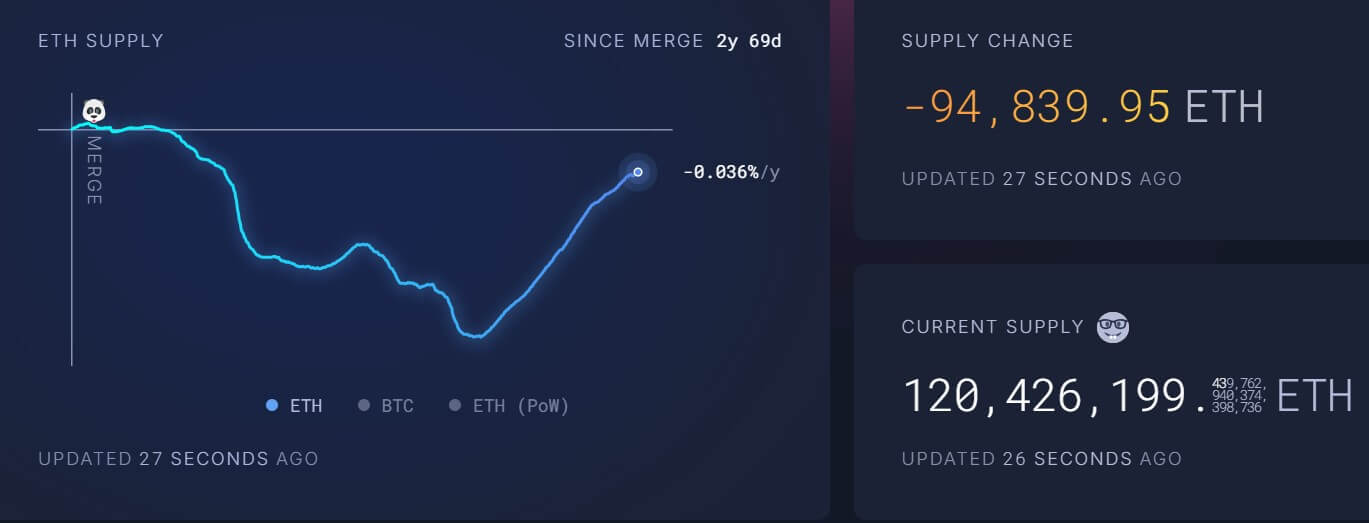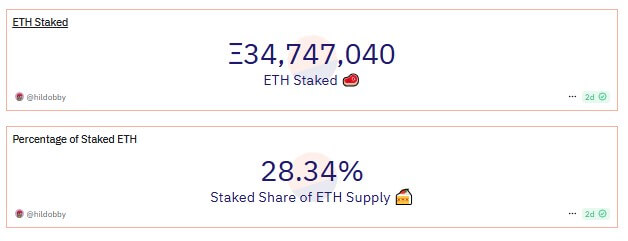Ethereum is undergoing its most prolonged inflationary period, with over 350,000 ETH (worth around $1.1 billion) added to its supply since the March Dencun upgrade, according to Ultrasound.money data. Ethereum’s current inflation rate is 0.35%.
The increase has brought the total supply to 120.4 million ETH, leaving just under 95,000 ETH to match the levels seen at the Ethereum Merge in Sept. 2022.

ETH’s nearly two years of supply reduction have been wiped out in just seven months since EIP-4844, also known as Dencun or Proto-Danksharding.
How Dencun altered Ethereum’s supply dynamics
The Dencun update introduced significant changes that reduced Ethereum’s base fee burn rate.
By allocating specific block space for layer-2 networks to process bundled transactions, known as blobs, competition for mainnet block space was reduced. Additionally, the proto-danksharding mechanism made data availability more efficient, causing base fees to drop sharply.
These events have severely impacted the blockchain network transaction fees, resulting in Ethereum issuing more ETH than it burns in most blocks.


For context, Ethereum burned 45,022 ETH while issuing 78,676 ETH over the last 30 days. This resulted in a net supply increase of over 30,000 ETH, underlining the inflationary impact of the reduced base fee environment.
Staking impact
The increase in Ethereum’s inflationary pressure is also linked to the rising ETH staking ratio. Coinbase analyst David Han noted that while the Dencun upgrade has significantly impacted Ethereum’s ecosystem, the inflation rate changes appear linked to broader factors, including the rising ETH staking ratio, which is accelerating all token issuance.
Ethereum’s move to Proof of Stake (PoS) has strengthened network security and boosted participation, but it has also resulted in more ETH being issued. Validators who lock up their ETH to secure the network earn rewards in newly minted tokens.


According to Dune Analytics data, approximately 34.7 million ETH—about 28% of the total supply—is currently staked. This staked ETH helps secure the network and generates rewards, further increasing Ethereum’s supply.
Additionally, the growing trend of restaking, especially with protocols like EigenLayer, amplifies this effect. Users reinvesting their staking rewards generate even more ETH, compounding the inflationary impact.
 Bitcoin
Bitcoin  Ethereum
Ethereum  Tether
Tether  XRP
XRP  USDC
USDC  Solana
Solana  TRON
TRON  Lido Staked Ether
Lido Staked Ether  Dogecoin
Dogecoin  Figure Heloc
Figure Heloc  Cardano
Cardano  WhiteBIT Coin
WhiteBIT Coin  Bitcoin Cash
Bitcoin Cash  Wrapped stETH
Wrapped stETH  Wrapped Bitcoin
Wrapped Bitcoin  USDS
USDS  Wrapped eETH
Wrapped eETH  Binance Bridged USDT (BNB Smart Chain)
Binance Bridged USDT (BNB Smart Chain)  Chainlink
Chainlink  Monero
Monero  LEO Token
LEO Token  WETH
WETH  Zcash
Zcash  Stellar
Stellar  Ethena USDe
Ethena USDe  Coinbase Wrapped BTC
Coinbase Wrapped BTC  Hyperliquid
Hyperliquid  Litecoin
Litecoin  Sui
Sui  Avalanche
Avalanche  Hedera
Hedera  sUSDS
sUSDS  Shiba Inu
Shiba Inu  USDT0
USDT0  Dai
Dai  Canton
Canton  PayPal USD
PayPal USD  Uniswap
Uniswap  Mantle
Mantle  Cronos
Cronos  World Liberty Financial
World Liberty Financial  Toncoin
Toncoin  Ethena Staked USDe
Ethena Staked USDe  Polkadot
Polkadot  USD1
USD1  Aave
Aave  Rain
Rain  Bitget Token
Bitget Token 


